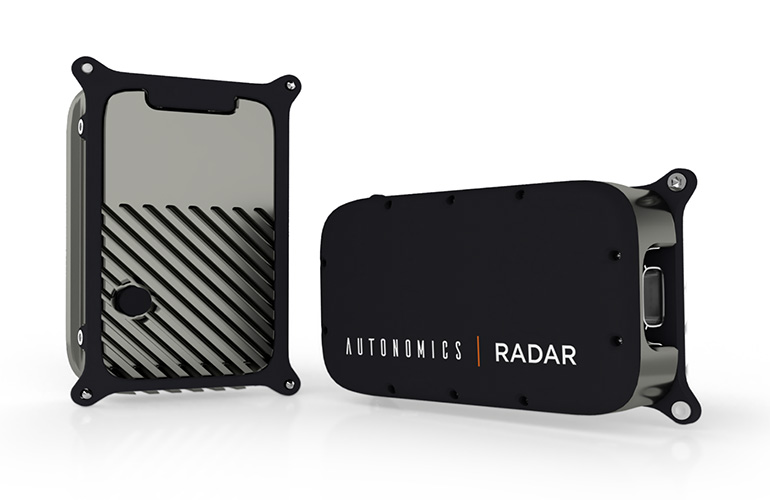|
Listen to this article  |

The RADAR unit is a software-defined sensor. The operating parameters of the device can be set and modified by software. | Credit: Autonomics
Cyprus-based Autonomics released the first version of its high-accuracy RADAR sensor. The new Autonomics MM 4D RADAR offers a new sensing modality for service robots that need to navigate safely in a collaborative environment around humans. The company is launching the first generation of the RADAR unit in Europe.
The RADAR sensor has a maximum sensing envelope of 150 m (492 ft) with 0.3 m (11.8 inch) resolution. In its short-range configuration, the resolution improves to 0.1 m (3.9 inch) under 50 M (164 ft).
The sensor is also described by Autonomics business development leader Rostislav Lopatkin as a “4D” sensor. The 4D (or fourth dimension here) is the velocity of items seen by the sensor. This means that the sensor can return a vector indicating the speed and motion of an item seen by the RADAR as part of the data stream. This is useful to help understand what things are moving and what things are stationary in the scene surrounding the vehicle.
One of the big advantages of RADAR over LiDAR is that RADAR can operate in inclement weather, including environmental situations such as rain, snow or foggy/smokey air. As a result, it can effectively perform obstacle detection in situations where LiDAR or even vision-guidance might fail to accurately image the area around a moving autonomous mobile robot (AMR) or autonomous vehicle.
The company is marketing the new sensor to both AMR developers as well as autonomous vehicle developers. The company has built a reference design, sweeping AMR to test and validate the RADAR sensor.
Device Features
- Unprecedented high resolution. Autonomics RADAR can determine the distance, velocity and also the boundaries of surrounding objects. This is a vital feature for solving obstacle avoidance tasks during autonomous driving.
- Wide angle of view. The antenna system based on a MIMO structure coupled with tailored embedded digital-signal-processing algorithms provides a horizontal field of view of up to 150 degrees. Safety is a crucial issue for autonomous service robots operating in unstructured environment shared with people. Autonomics RADAR’s wide field of view along with its high resolution and capability of obstacle detection in any weather and lighting conditions ensures the robot operates safely.
- The software-defined characteristics make Autonomics RADAR flexible and adaptable to any required applications and conditions. Detection range, azimuth field of view, range and velocity resolution, and accuracy can be customized over a wide range.
- Easy-to-integrate into existing systems with full ROS compatibility.
The unit is a software-defined sensor. This means that the operating parameters of the device can be set and modified by software, without having to modify the sensor physically. The sensor has two primary operating modes: short-range mode and long-range mode. Changing the mode of operation modifies the accuracy and resolution of data gathered by the device.
The radar module is based on a Texas Instruments AWR2243 system-on-a-chip cascade. The computing module based on automotive-grade SoC performs radar signal processing and interaction with external systems via Ethernet and CAN interfaces. The unit is also completely ROS compatible.
For complete radar specifications, see the datasheet: https://www.autonomics.tech/radar
Credit: Source link


Comments are closed.